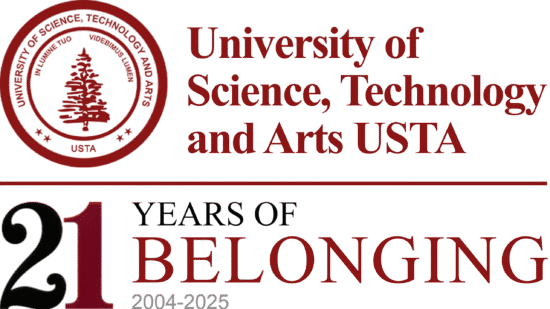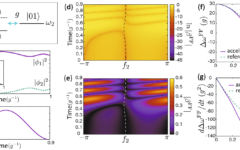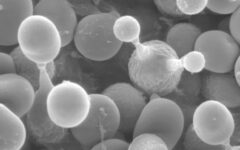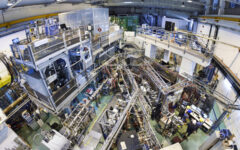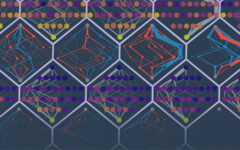Physics of bubbles could explain language patterns
16 August 2023 2023-08-16 13:32Physics of bubbles could explain language patterns
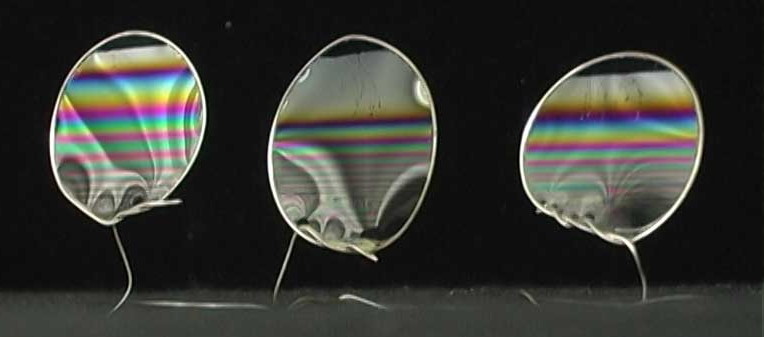
Physics of bubbles could explain language patterns
Source: University of Portsmouth Summary: Language patterns could be predicted by simple laws of physics, a new study has found. A theory using ideas from physics predicts where and how dialects occur.
Language patterns could be predicted by simple laws of physics, a new study has found.
Dr James Burridge from the University of Portsmouth has published a theory using ideas from physics to predict where and how dialects occur.
He said: “If you want to know where you’ll find dialects and why, a lot can be predicted from the physics of bubbles and our tendency to copy others around us.
“Copying causes large dialect regions where one way of speaking dominates. Where dialect regions meet, you get surface tension. Surface tension causes oil and water to separate out into layers, and also causes small bubbles in a bubble bath to merge into bigger ones.
“The bubbles in the bath are like groups of people — they merge into the bigger bubbles because they want to fit in with their neighbours.
“When people speak and listen to each other, they have a tendency to conform to the patterns of speech they hear others using, and therefore align their dialects. Since people typically remain geographically local in their everyday lives, they tend to align with those nearby.”
Dr Burridge from the University’s department of mathematics departs from the existing approaches in studying dialects to formulate a theory of how country shape and population distribution play an important role in how dialect regions evolve.
Traditional dialectologists use the term ‘isogloss’ to describe a line on a map marking an area which has a distinct linguistic feature.
Dr Burridge said: “These isoglosses are like the edges of bubbles — the maths used to describe bubbles can also describe dialects.
“My model shows that dialects tend to move outwards from population centres, which explains why cities have their own dialects. Big cities like London and Birmingham are pushing on the walls of their own bubbles.
“This is why many dialects have a big city at their heart — the bigger the city, the greater this effect. It’s also why new ways of speaking often spread outwards from a large urban centre.
“If people live near a town or city, we assume they experience more frequent interactions with people from the city than with those living outside it, simply because there are more city dwellers to interact with.
His model also shows that language boundaries get smoother and straighter over time, which stabilises dialects.
Dr Burridge’s research is driven by a long-held interest in spatial patterns and the idea that humans and animal behaviour can evolve predictably. His research has been funded by the Leverhulme Trust.
Related Posts
Synchrotron sheds (X-ray) light on carbon chemistry at ocean surfaces
Frequency modulation accelerates the research of quantum technologies
Fungal spores harness physics to launch themselves
Physics: Toward a practical nuclear pendulum
Physics explains protein unpredictability
Search
Categories
- Acoustics (1)
- Admission (14)
- Alumni (19)
- Bacteria (1)
- Behavioral Science (1)
- Biochemistry (1)
- Biochemistry Research (1)
- Biology (1)
- Biotechnology (1)
- Blog (10)
- Botany (1)
- Career (14)
- Cell Biology (1)
- Chemistry (1)
- Chemistry (1)
- Developmental Biology (1)
- Epigenetics Research (1)
- Evolutionary Biology (1)
- Fungus (1)
- Fungus (1)
- Genetics (1)
- Health (1)
- Inorganic Chemistry (1)
- Life Sciences (1)
- Marine Biology (1)
- Mating and Breeding (1)
- Microbes and More (1)
- Microbiology (1)
- Molecular Biology (1)
- Nature of Water (1)
- News (39)
- Optics (1)
- Organic Chemistry (1)
- Physics (1)
- Prions (1)
- Prions (1)
- Quantum Computing (1)
- Quantum Physics (1)
- Research (38)
- Spotlight (15)
- Student life (15)
- Student story (13)
- Technology (1)
- Thermodynamics (1)
- Ultrasound (1)
- Uncategorized (10)
- Virology (1)
- Zika Virus Research (1)
- Zoology (1)
Get the latest University of Science, Technology and Arts news
Carborane-Cluster-Wrapped Copper Cluster with Cyclodextrin-like Cavities for Chiral Recognition | Journal of the American Chemical Society #Carborane #Cluster #Cu #Cyclodextrin #Chiral #Recognition
This week in #LCSOSynthesisProblem @DuncanBrownsey challenged us with the total synthesis of Wickerol A and B by Gui and coworkers @Jinghan_Gui in @J_A_C_S. #TotalSynthesis #Chemistry
Take a look: https://www.epfl.ch/labs/lcso/wp-content/uploads/2024/06/Wickerol-A-Gui-2020.pdf
Original paper: https://pubs.acs.org/doi/10.1021/jacs.9b11838
Modified Halloysite as Catalyst for the Conversion of Hydroxymethylfurfural to Furandicarboxylic Acid: A DFT Investigation (Dario Duca and co-workers)
Topological electride of 𝑡-YCl, Yiwei Liang, Xinyan Lin, Biao Wan, Zhaopeng Guo, Xuyan Cao, Dexi Shao, Jian Sun, and Huiyang Gou #CondensedMatter #ChemicalPhysics https://go.aps.org/3VwcMZ5
G-Quadruplex mRNAs Silencing with Inducible Ribonuclease Targeting Chimera for Precision Tumor Therapy | Journal of the American Chemical Society #Quadruplex #mRNA #Silencing #Ribonuclease #Chimera #Tumor #Therapy
Polycationic Open‐Shell Cyclophanes: Synthesis of Electron‐Rich Chiral Macrocycles, and Redox‐Dependent Electronic States – Shi – Angewandte Chemie International Edition – Wiley Online Library
Perspective on the Development of Monomer Recovery Technologies from Plastics Designed to Last
A Perspective by Steffan K. Kristensen, Troels Skrydstrup et al. @AarhusUni_int
🔓 Open access in ACS Organic & Inorganic Au 👉 https://go.acs.org/9Gv
A fantastic collection of activities to provoke and deepen mathematical thinking. ‘Thinkers’ will enhance the teaching and learning of mathematics for new and experienced teachers, and for learners from 8 to 18 (and beyond). http://bit.ly/ATMthinkers.
ICYMI, from our Emerging Investigators collection 🎉
‘Gold-catalyzed benzannulations of 2-alkenylindoles with alkynes: a protecting-group-free regioselective approach to carbazoles’ by Youliang Wang at Xi’an Jiaotong University.
Catalyst-Free α-trans-Selective Hydroboration and (E)-Selective Deuterated Semihydrogenation of Alkynyl Sulfones (@JOC_OL): https://pubs.acs.org/doi/10.1021/acs.joc.3c02833.
https://www.organic-chemistry.org/abstracts/lit3/936.shtm
A simple continuous hydrogenation of alkenes and alkynes with in situ generated diimide
Molecular Triplet Generation Enabled by Adjacent Metal Nanoparticles | Journal of the American Chemical Society #Triplet #Generation #Metal #Nanoparticles
Photonic implementation of the quantum Morra game, Andrés Ulibarrena, Alejandro Sopena, Russell Brooks, Daniel Centeno, Joseph Ho, Germán Sierra, and Alessandro Fedrizzi #Quantum #QuantumInformation https://go.aps.org/45eWCru
We’re excited to share our latest preprint on @ChemRxiv! The talented @Zhipengluu developed a new photo-active hypervalent iodine reagent for the diversification of aliphatic C–H bonds. Check it out: https://chemrxiv.org/engage/chemrxiv/article-details/665755b321291e5d1d8dfdbf
Now in @InorgChem! Read the article featuring pyrazine (pz)-bridged dinuclear Ru2(II,II) and Ru2(III,III) complexes and pz-containing mononuclear Ru(II) and Ru(III) complexes, which were afforded through the reactions of the (μ-Cl)3 Ru(II,II) complex: https://go.acs.org/9Gq
Long-Range Gating in Single-Molecule One-Dimensional Topological Insulators | Journal of the American Chemical Society @ColumbiaScience @Columbia @ChemColumbia @APAMMSECU #Gating #Topological #Insulators
Diastereo- and Enantioselective Construction of Stereochemical Arrays Exploiting Non-Classical Hydrogen Bonding in Enolborates (@ChemEurJ): https://chemistry-europe.onlinelibrary.wiley.com/doi/10.1002/chem.202401485.
A Review on the Recent Advances in Developing Radical Methods for the Synthesis of Aliphatic Sulfonyl Fluorides by Zhong-Yan Cao, Saihu Liao, and co-workers
